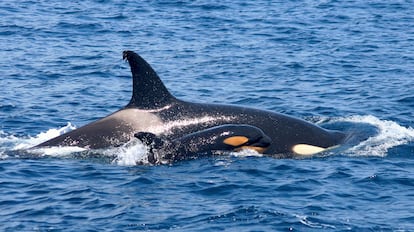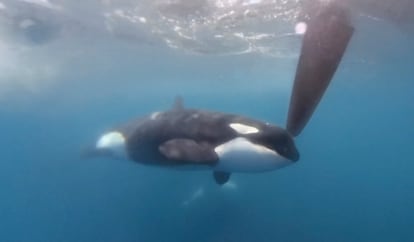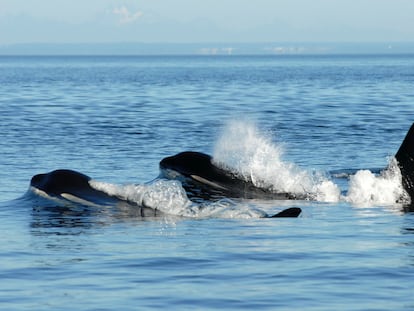Gladys orcas sink another sailboat in the Strait of Gibraltar: ‘They don’t go like a battering ram’
Since May 2020 the pod of 15 Iberian killer whales has sunk seven vessels — five sailboats and two Moroccan fishing boats — in waters that coincide with their migratory route

In the first case of a boat being sunk by killer whales this year, the Spanish Coast Guard reported that at 9 a.m. Sunday the two crew members of the sailboat Alborán Cognac sent an SOS after an encounter with orcas 14 nautical miles from Cape Espartel, at the southern entrance of the Strait of Gibraltar in Moroccan waters, stating their vessel had been damaged. The sailors explained that they had felt blows on the hull and suffered rudder damage and, more seriously, a breach that could sink the 15-meter-long sailboat. Given the urgency of the situation, a helicopter was scrambled and the tanker MT Lascaux, which was “sailing nearby, was requested to divert to the position of the sailboat to provide assistance,” said sources from the Spanish Ministry of Transport.
At the same time Moroccan authorities were alerted and the crew members were instructed to put on their life jackets and to turn on the AIS (Automatic Identification System), as well as to have “the radio beacons ready” in case they needed to be located. An hour after the SOS was send, at 10 a.m., the two sailors were safe and sound on board the tanker, which transported them to Gibraltar. Nothing could be done to save the sailboat, which drifted and eventually sank.
Experts who study the behavior of orcas in the Strait of Gibraltar believe that the specimens behind this latest incident are the Iberian killer whales collectively known as Gladys, a pod of 15 whales belonging to the population of around 37 that live between the north of the Iberian Peninsula and the Strait of Gibraltar. The first documented incident of this type occurred in May 2020 and, adding this weekend’s encounter, seven shipwrecks have now been recorded: five sailboats and two Moroccan fishing boats, the latter of which were in very poor condition.
The encounters occur mainly on the Atlantic coast of the Iberian Peninsula but also in adjacent areas of France and Morocco, the migratory route of these cetaceans as they follow schools of tuna, their main food source. The latest data from the Atlantic Orca Working Group (GTOA), an organization that contributes to the animals’ conservation and management, indicate that there have been at least 673 interactions (when the orcas approach a boat with or without contact), since the Gladys began to display this unusual behavior.

Orca attacks not intentional, say experts
Experts argue that these are not intentional attacks, but rather learned behavior that may be related to their curiosity, their fondness for play, or some form of caution that leads them to want to stop the boat. “They don’t go like a battering ram to attack the ship and sink it, and they might do so if that were their intention,” says Alfredo López, a marine biologist and spokesman for GTOA. It is also not known if these attacks are the result of a trigger that results in behavior that is atypical in the species.
Although there is no pattern, and their behavior varies, the Gladys tend to sneak up on a boat, often without the crew noticing, to get underneath it. They then begin to bump against it and to hit the rudder with their heads, sometimes breaking it with the leverage exerted. “A breach can even occur and sailboats do not usually have adequate pumps to expel the amount of water they take on, so the boat can sink,” explains López.
The favorites of these 15 killer whales, which are divided into at least four groups, are sailboats — both monohulls (72%) and catamarans (14%) — with an average length of 12 meters, although interactions with motorboats (6%), semi-rigid vessels (5%) and fishing boats (3%) have also been observed, according to GTOA.
How should sailors react if orcas approach their vessel? The Ministry of Transport offers recommendations on its website for navigation in the Gulf of Cádiz and the Strait of Gibraltar. The measures are applicable throughout the year — but especially between the months of April and August, the time when most interactions occur — and always only if possible and will not potentially generate greater danger. In the first instance, the ministry states, it is advisable to avoid navigating in the area delimited in the map published on its website and, if that is not possible, to remain as close as possible to the coast, within safety guidelines.
If an encounter is unavoidable, the best thing to do is not to stop the vessel (whether it is a motor or sailboat) and to make for the coast and shallower waters. At the same time, those on board should avoid approaching the sides of the boat as the sudden movements caused by killer whales can cause injury or result in falling into the sea. Nor should deterrent measures be used that may cause death, harm, or stress to the whales, for example firing flares at them, which has been reported on occasion. Lastly, the sighting of or interaction with the cetaceans should be transmitted to the nearest Rescue Coordination Center through VHF channels.
Sign up for our weekly newsletter to get more English-language news coverage from EL PAÍS USA Edition
Tu suscripción se está usando en otro dispositivo
¿Quieres añadir otro usuario a tu suscripción?
Si continúas leyendo en este dispositivo, no se podrá leer en el otro.
FlechaTu suscripción se está usando en otro dispositivo y solo puedes acceder a EL PAÍS desde un dispositivo a la vez.
Si quieres compartir tu cuenta, cambia tu suscripción a la modalidad Premium, así podrás añadir otro usuario. Cada uno accederá con su propia cuenta de email, lo que os permitirá personalizar vuestra experiencia en EL PAÍS.
¿Tienes una suscripción de empresa? Accede aquí para contratar más cuentas.
En el caso de no saber quién está usando tu cuenta, te recomendamos cambiar tu contraseña aquí.
Si decides continuar compartiendo tu cuenta, este mensaje se mostrará en tu dispositivo y en el de la otra persona que está usando tu cuenta de forma indefinida, afectando a tu experiencia de lectura. Puedes consultar aquí los términos y condiciones de la suscripción digital.
More information
Archived In
Últimas noticias
Welcome to the post-religion era: The idea of Christianity as the absolute truth has become obsolete
‘I thought you would like it’: The risky sexual practice popularized by TV shows and TikTok
The digitalization of tourism: ‘They promise experiences and gave us the worst possible one’
Mexican peso defies uncertainty with forecasts of a new period of stability in 2026
Most viewed
- Sinaloa Cartel war is taking its toll on Los Chapitos
- Reinhard Genzel, Nobel laureate in physics: ‘One-minute videos will never give you the truth’
- Oona Chaplin: ‘I told James Cameron that I was living in a treehouse and starting a permaculture project with a friend’
- Why the price of coffee has skyrocketed: from Brazilian plantations to specialty coffee houses
- Silver prices are going crazy: This is what’s fueling the rally










































